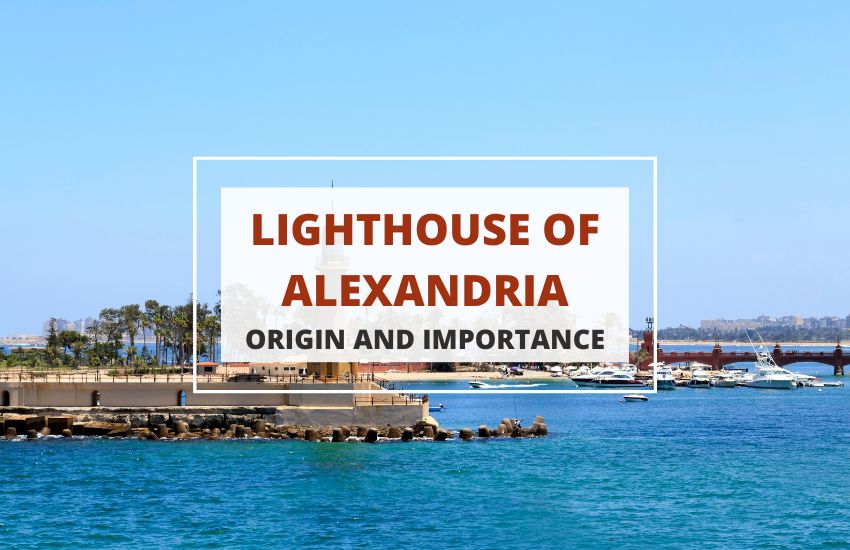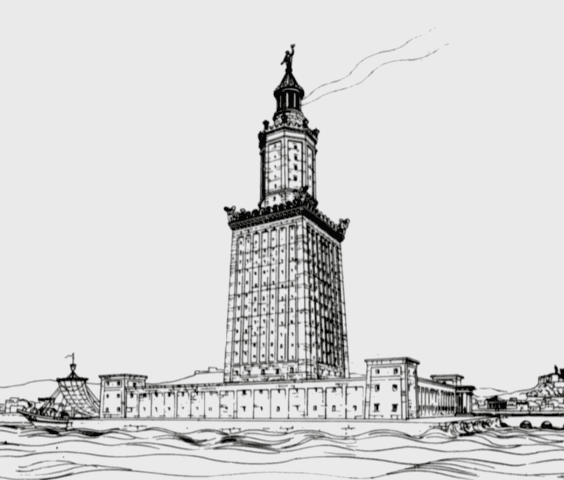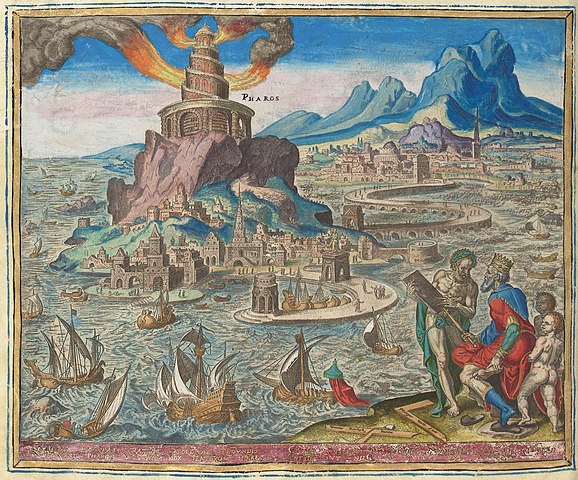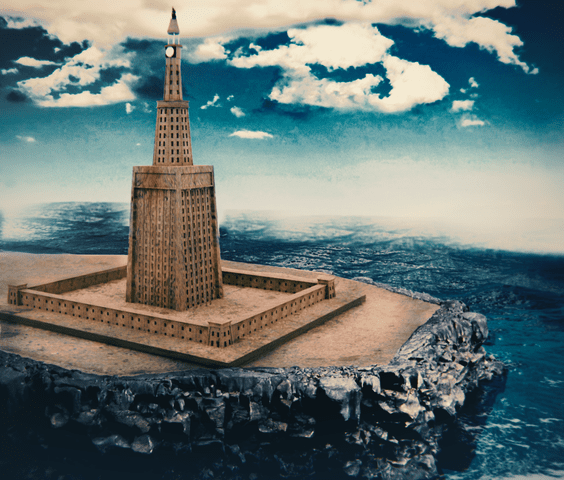
Table of Contents
Alexandria is a city in Egypt that people recognize for its ancient history. Alexander the Great founded it in 331 BCE, so it’s one of the oldest metropolises in the world. It was a pivotal location during the Hellenic period.
This city also housed one of the Seven Wonders of the Ancient World, the Lighthouse of Alexandria, sometimes called the Pharos of Alexandria. This lighthouse wasn’t the first to be built, but it is unquestionably the most notable one in history.
In this article, you’ll learn all you need to know about this lighthouse that was once erected in Alexandria.
What Was the History of The Lighthouse of Alexandria?

This architectural masterpiece’s history intertwines with the city of Alexandria. The city received the nicknames “the pearl of the Mediterranean” and “the trading post of the world.”
The reason for this was that Alexandria housed the most important part of the Hellenic civilization, aside from the fact that it became the go-to for education, politics, and architecture for those in power in this period of time.
Alexandria was popular for many of its structures, including its library, which held an uncountable number of books on an extensive list of topics, its Mouseion, dedicated to art and the worship of deities, and the renowned Lighthouse.
The person who ordered the construction of the pharos was Ptolemy I, the King of Egypt. The reason why he ordered it was that, despite the fact that Alexandria was the most prominent port in the Mediterranean valley, the coast was extremely dangerous.
So, in the face of not having any visible landmarks on the coast side, and also having frequent shipwrecks due to a reef barrier, Ptolemy I had the Lighthouse constructed on the island of Pharos, so the ships arrived safely at Alexandria’s harbor.
This construction greatly helped the economy of Alexandria. Trading and merchant ships could not come freely and safely towards the dangerous coast, which helped the city to gain and display power to those who arrived at the port.
However, there were several earthquakes that occurred between 956-1323 CE. As a consequence of these earthquakes, the structure of the Lighthouse of Alexandria was gravely damaged, and it eventually became deserted.
What Did the Lighthouse Look Like?
Even though no one knows for sure what the lighthouse actually looked like, there’s a general idea that has taken form thanks to multiple accounts that match in some aspects, although they do also deviate from each other in others.

In 1909, Herman Thiersch wrote a book called Pharos, antike, Islam und Occident, which is still in print in case you wanted to check it out. This work has much of what is known about the lighthouse, as Thiersch consulted ancient sources to give the most complete picture we have of the lighthouse.
Accordingly, the lighthouse was constructed in three stages. The first stage was square, the second was octagonal, and the final level was cylindrical. Each section sloped slightly inwards and was accessible by a wide, spiral ramp that went all the way to the top. At the very top, a fire burned throughout the night.
Some reports say that a massive statue on the lighthouse, but the subject of the statue is still unclear. It may have been Alexander the Great, Ptolemy I Soter, or even Zeus.
The Lighthouse of Alexandria had a height of around 100 to 130 meters, was made of limestone and decorated with white marble, and had three floors. Some accounts say that there were government offices on the first floor.
A report by Al-Balawi, a Muslim scholar who visited Alexandria in 1165, goes like this:
“…a guide to voyagers, for without it they could not find the true course to Alexandria. It can be seen for more than seventy miles, and is of great antiquity. It is most strongly built in all directions and competes with the skies in height. Description of it falls short, the eyes fail to comprehend it, and words are inadequate, so vast is the spectacle. We measured one of its four sides and found it to be more than fifty arms’ lengths [almost 112 feet]. It is said that in height it is more than one hundred and fifty qamah [the height of a man]. Its interior is an awe-inspiring sight in its amplitude, with stairways and entrances and numerous apartments, so that he who penetrates and wanders through its passages may be lost. In short, words fail to give a conception of it.”
How Did the Lighthouse Work?

Historians believe that the building’s objective may not have been to function as a lighthouse at first. There are also no records that explain in detail how the mechanism at the top of the structure worked.
However, there are some accounts like the one from Pliny the Elder, where he described that at night, they used a flame that lit up the top of the tower and in consequence the near areas, helping ships know where they should go at night.
Another account by Al-Masudi states that during the day, they used a mirror at the lighthouse to reflect sunlight towards the sea. This made the lighthouse useful during both the day and night.
Aside from guiding sailors, the Lighthouse of Alexandria performed another function. It showcased the authority of Ptolemy I since it was because of him that the second-highest structure built by humans existed.
How Did the Lighthouse of Alexandria Disappear?
As we mentioned before, the reason why the Lighthouse of Alexandria disappeared was that between 956-1323 CE, there were several earthquakes. These also created tsunamis which weakened its structure over time.
The lighthouse began deteriorating until eventually a part of the tower collapsed completely. After this, the Lighthouse was abandoned.
After about 1000 years, the Lighthouse gradually disappeared completely, a reminder that all things will pass with time.
Significance of the Lighthouse of Alexandria

According to historians, the Lighthouse of Alexandria was built between 280-247 BCE. People also consider it one of the Seven Wonders of the Ancient World because it was one of the most advanced constructions ever done at the time.
Even though it doesn’t exist anymore, people believe that this structure had an important role in creating “Pharos.” This Greek term refers to the architectural style in which a building helps direct sailors with the help of a light.
Interestingly, the Lighthouse of Alexandria was the second-highest building built by human hands after the Pyramids of Giza, which only adds to how outstanding the construction of this lighthouse was.
The Lighthouse would also influence minaret constructions, which would come later on. It became so prominent to the point there were similar pharos all along the harbors of the Mediterranean sea.
Origin of The Term Pharos
Despite the fact there’s no record of where the original term comes from, Pharos was originally a small island on the coast of the Nile Delta, opposite the peninsula where Alexander the Great founded Alexandria around 331 BCE.
A tunnel called the Heptastadion later connected these two locations. It had the Great Harbor toward the tunnel’s eastern side and Eunostos’ port on the western side. Plus, you could find the lighthouse standing on the easternmost point of the island.
Nowadays, neither the Heptastadion nor the Lighthouse of Alexandria is still standing. The modern city’s expansion helped the destruction of the tunnel, and most of the island of Pharos has disappeared. Only the Ras el-Tin area, where the homonymous palace is, remains.
Wrapping Up
Alexandria is a city that has a rich ancient history. Its structures, despite being destroyed, were so notable and distinguished that we still talk about them today. The Lighthouse of Alexandria is proof of that.
When it was built, the Lighthouse was the second tallest construction by humans, and its beauty and size were such that all who looked at it were amazed. Today, it remains one of the seventh wonders of the ancient world.








